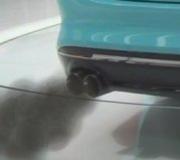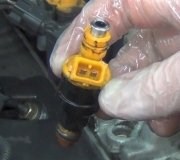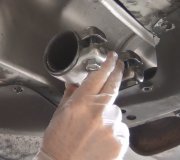These problems are likely all related, and not to the catalytic converter and most likely not the "mechanic-in-a-can". Dirty injectors will cause restricted fuel flow or an injector that won't seal. That will lead to fuel pressure bleeding off and a real long crank time to get the engine started. Once running, it will typically run fine.
To have so much over-fueling that it leaves black smoke is usually caused by something beyond the Engine Computer's control. He can only adjust fuel metering by plus or minus 10 percent over the pre-programmed values. If it's asking for more fuel you will need a scanner that can read live data while driving to see what the computer sees.
There are three things that can lead to more than the ideal amount of fuel entering the engine. More fuel enters than what the computer thinks it commanded, the oxygen sensors are detecting unburned oxygen and the computer wants more fuel to go with it for proper combustion and lower emissions, or one injector has a low flow rate and is running lean.
If all the sensor readings look good on the scanner and the "short-term-fuel-trim" (STFT) numbers are close to "0", that means the computer is happy with the amount of fuel programmed in at the factory and is not modifying the amount by plus or minus anything. Adjusting the mixture by plus or minus 2 - 5 percent is common. When these numbers are low, no excessive unburned oxygen is being detected, but beginning with the '96 models, excessive fuel should be picked up by the failure of the downstream O2 sensor to go lean at some point. Regardless of the cause, extra fuel is not detected and if the computer didn't request it, suspect fuel pressure is too high or an injector is leaking. Cars with a vacuum hose going to the fuel pressure regulator can have a cracked or disconnected vacuum hose or in rare cases, a crushed or blocked return line to the tank.
The mass air flow sensor has the biggest say in how much fuel is needed. Between it and the throttle position sensor, fuel metering is pretty accurate but it is fine tuned according to the oxygen sensors' readings. If extra air sneaks in through a vacuum leak, that will get detected as a lean condition and the computer will command more fuel. No matter how much extra fuel is commanded, there will still be that extra air showing up in the exhaust. Proof of a leak will show up as very high positive fuel trim numbers since the computer is asking for a lot more fuel in a misguided attempt at stabilizing the mixture.
More commonly, a misfire will send unburned fuel and oxygen into the exhaust. This results in excessive heat buildup in the catalytic converter. If it's real bad the converter could start to glow orange. The oxygen sensor for that side of the engine will detect the unburned oxygen and report a lean condition to the computer. (O2 sensors don't detect unburned fuel). The computer will respond by adding more fuel to those four injectors. This usually isn't a problem on '96 and newer models because misfires are detected by the slowdown in crankshaft rotational speed, the same thing that lets us feel them, and if excessive, will turn on the Check Engine light and set a diagnostic fault code in memory.
The third potential cause of too much fuel pertains only to GM vehicles with higher mileage. It has to do with mismatched flow rates of the injectors. Chrysler buys their injectors from Bosch in matched sets and problems with them are just about unheard of. They last well beyond the life of the car. GM grabs a handful of injectors out of a huge bin and throws them in an engine with no regard to matching their flow rates. As the engine ages and the injectors begin to show a little wear, some will not flow as much fuel as the rest resulting in one or two cylinders running lean. Here again, the unburned oxygen is detected, but the computer doesn't realize that is being caused by only a few cylinders, so it asks for more fuel from all of the injectors, even those that are flowing too much fuel already. This can be a hard one to figure out because there isn't exactly a defect that can be easily diagnosed. Now that it has become more widely known, there is a company that specializes in rebuilding injectors and GM injectors are their most popular product. They are flow-matched and sold only in matched sets. Many owners claim their engines never ran so smoothly since the car was new.
The mismatched flow rates coupled with deposits in the injectors could lead to excessive fuel consumption, but for the most part, even the cheapest fuels today have more and better additives that keep the fuel system clean. It still can't hurt to run some injector cleaner through the system, but rather than looking for an improvement in engine performance and fuel consumption, look for a change in those factors. If the engine runs better or worse, look closer at the injectors. If there's no change, as I expect, look at vacuum hoses, fuel pressure, and other things like that which are not monitored directly by the computer.
One last thing to consider is an exhaust leak ahead of the front oxygen sensors. Between the puffs of exhaust flow, the momentum creates little pulses of vacuum that can draw in outside air. The oxygen in that air will be detected as a lean condition. No matter how much extra fuel the computer commands, there will still be that oxygen sneaking in and the computer will keep on raising the amount of fuel it wants. This will also be seen as real high positive fuel trim numbers.
Wednesday, July 13th, 2011 AT 7:17 PM



